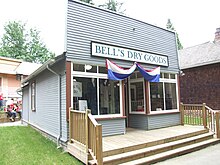

Dry goods is a historic term describing the type of product line a store carries, which differs by region. The term comes from the textile trade, and the shops appear to have spread with the mercantile trade across the British Empire (and former British territories) as a means of bringing supplies and manufactured goods to far-flung settlements and homesteads. Starting in the mid-18th century, these stores began by selling supplies and textile goods to remote communities, and many customized the products they carried to the area's needs. This continued to be the trend well into the early 20th century. With the rise of department stores and catalog sales, the decline of dry goods stores began, and the term has largely fallen out of use. Some dry goods stores became department stores especially around the turn of the 20th century.
The term goes back to the 17th century and originally referred to any goods measured in dry measure, not liquid measure, of volume, such as stere, bushel or peck. Dry goods as a term for textiles dates back to 1742 in England[1] or even a century earlier.[2]
© MMXXIII Rich X Search. We shall prevail. All rights reserved. Rich X Search
